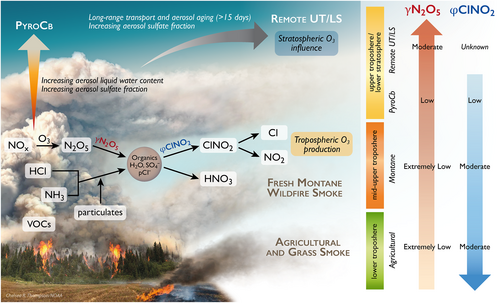
Airborne Observations Constrain Heterogeneous Nitrogen and Halogen Chemistry on Tropospheric and Stratospheric Biomass Burning Aerosol
Zachary C. J. Decker , Gordon A. Novak, Kenneth Aikin, Patrick R. Veres, J. Andrew Neuman, Ilann Bourgeois, T. Paul Bui, Pedro Campuzano‐Jost, Matthew M. Coggon, Douglas A. Day, Joshua P. DiGangi, Glenn S. Diskin, Maximilian Dollner, Alessandro Franchin, Carley D. Fredrickson, Karl D. Froyd, Georgios I. Gkatzelis, Hongyu Guo, Samuel R. Hall, Hannah Halliday, Katherine Hayden, Christopher D. Holmes, Jose L. Jimenez, Agnieszka Kupc, Jakob Lindaas, Ann M. Middlebrook, Richard H. Moore, Benjamin A. Nault, John B. Nowak, Demetrios Pagonis, Brett B. Palm5, Jeff Peischl, Felix M. Piel, Pamela S. Rickly, Michael A. Robinson, Andrew W. Rollins, Thomas B. Ryerson, Gregory P. Schill, Kanako Sekimoto, Chelsea R. Thompson, Kenneth L. Thornhill, Joel A. Thornton, Kirk Ullmann, Carsten Warneke, Rebecca A. Washenfelder, Bernadett Weinzier, Elizabeth B. Wiggins, Christina J. Williamson, Edward L. Winstead, Armin Wisthaler, Caroline C. Womack, Steven S. Brown
Geophysical Research Letters
Geophysical Research Letters, 51, e2023GL107273
Publication Date: February 12, 2024
Open Access
© Author(s) 2024. This work is distributed under
the Creative Commons Attribution 4.0 License.
Abstract.
Heterogeneous chemical cycles of pyrogenic nitrogen and halides influence tropospheric ozone and affect the stratosphere during extreme Pyrocumulonimbus (PyroCB) events. We report field-derived N2O5 uptake coefficients, γ(N2O5), and ClNO2 yields, φ(ClNO2), from two aircraft campaigns observing fresh smoke in the lower and mid troposphere and processed/aged smoke in the upper troposphere and lower stratosphere (UTLS). Derived φ(ClNO2) varied across the full 0–1 range but was typically <0.5 and smallest in a PyroCB (<0.05). Derived γ(N2O5) was low in agricultural smoke (0.2–3.6 × 10−3), extremely low in mid-tropospheric wildfire smoke (0.1 × 10−3), but larger in PyroCB processed smoke (0.7–5.0 × 10−3). Aged biomass burning aerosol in the UTLS had a higher γ(N2O5) of 17 × 10−3 that increased with sulfate and liquid water, but that was 1–2 orders of magnitude lower than values for aqueous sulfuric aerosol used in stratospheric models.
